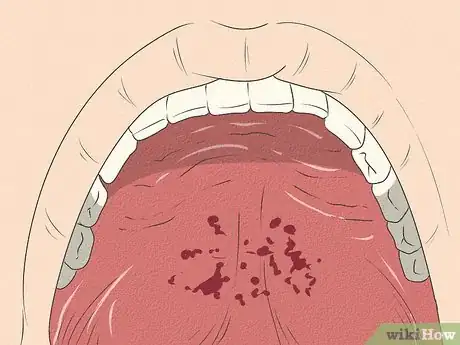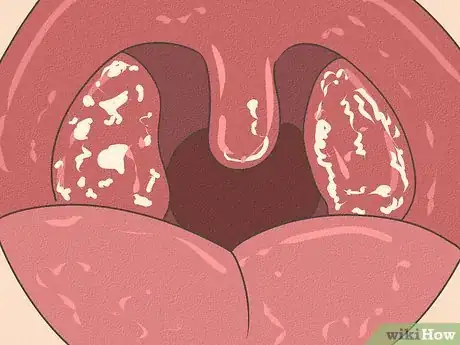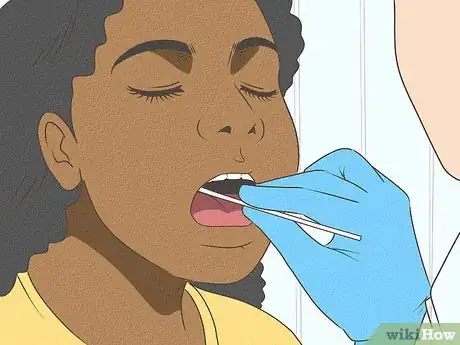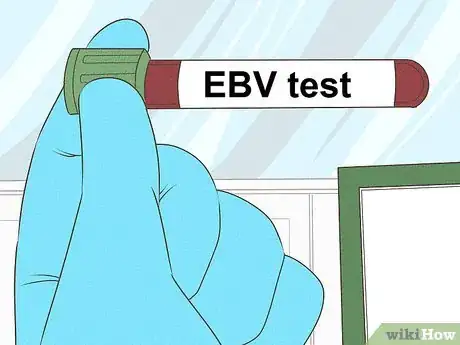This article was medically reviewed by Janice Litza, MD. Dr. Litza is a board certified Family Medicine Physician in Wisconsin. She is a practicing Physician and taught as a Clinical Professor for 13 years, after receiving her MD from the University of Wisconsin-Madison School of Medicine and Public Health in 1998.
There are 9 references cited in this article, which can be found at the bottom of the page.
wikiHow marks an article as reader-approved once it receives enough positive feedback. In this case, several readers have written to tell us that this article was helpful to them, earning it our reader-approved status.
This article has been viewed 151,430 times.
Tonsillitis, or the inflammation of the tonsils, is a common cause of sore throats – especially in children and young adults.[1] Tonsillitis is usually caused by a virus and resolves on its own, but about 15 – 30% of the time it’s due to a bacterial infection in the tonsils that requires treatment with antibiotics.[2] Though you cannot truly know whether your tonsillitis is bacterial or viral without getting tested by your doctor, knowing symptoms more common to each cause can help you recognize when you should see your doctor for treatment.
Steps
Recognizing Common Viral Symptoms
-
1Recognize a runny nose as a viral symptom. If a virus causes your tonsillitis, you’re more likely to have a runny or stuffy nose. A general feeling of being unwell and a fever can occur with either viral or bacterial infection, but the fever is usually lower if you have a virus – closer to 100.4°F (38°C) than 102°F (38.9°C).[3]
-
2Consider a viral cause for your cough. You may have a cough with either cause, but a cough and a husky voice are more commonly associated with viral illness. Coughing and voice changes can be caused by laryngitis, usually a viral ailment that goes along with tonsillitis.[4]Advertisement
-
3Notice if you start improving within four days. Tonsillitis caused by a virus usually goes away or at least begins to improve within three to four days, so if you start to feel better after that time you likely have a passing viral infection. Bacterial tonsillitis can last much longer, or even until medically treated.[5]
- See your doctor if you see no improvement in symptoms after four days — you may have a bacterial infection requiring antibiotics.
- Even viral tonsillitis can last up to two weeks, so a longer illness isn’t a definite sign of a bacterial infection.[6]
-
4Get tested for Epstein-Barr virus (EBV) if you have constant fatigue. EBV is the usual cause of mononucleosis, or “mono.” Mono is a common cause of tonsillitis in young adults and teens. Mono can last for weeks, and is often associated with fatigue, sore throat and tonsillitis, fever, swollen lymph nodes in the neck and armpits, and headache.[7]
- Mono will pass on its own and usually doesn’t require treatment, but you should still get diagnosed. This can be done with a simple blood test.
-
5Check the roof of your mouth for a rash. Some people with mono also get a pinpoint red, speckled rash on the roof of their mouth. Open wide and look at the top of your mouth in a mirror. Red speckles can indicate mono.[8]
- Mono can occur with or without a skin rash, too.
- While looking in your mouth, also check for a gray membrane covering your tonsils. This is another sign of mono.[9]
-
6Feel for tenderness over your spleen. Gently feel over the area of your spleen — under your ribcage, above your stomach, on the left side of your torso. Your spleen may enlarge if you have mono and feel tender when pressed. Be gentle! A swollen spleen can rupture if handled roughly.[10]
Identifying Complications of Bacterial Tonsillitis
-
1Check your tonsils for white spots. Your tonsils are the glands that sit at the back of your mouth on both sides of your throat. Bacterial tonsillitis may cause small, white, pus-filled spots on your tonsils.[11] Look in a mirror, open your mouth wide, and look closely at the tissue on either side of the back of your throat. If it’s too hard to see, get a family member to look for you and try shining a light back there.
- It’s normal for your tonsils to look red and swollen with bacterial or viral tonsillitis – the white, pus-filled spots are more common to bacterial infections.
-
2Feel your neck for swollen lymph nodes. Use your pointer and middle fingers to gently press along both sides of your neck, on your throat under the angle of your chin, and behind your ears. Feel for a hard or tender lump about the size of your pinkie fingernail. This could be a swollen lymph node. Though your lymph nodes can swell any time your body is fighting an infection, swollen nodes are more common with bacterial infections.[12]
-
3Consider an ear infection an indication that bacteria are present. Sometimes, bacteria from a throat infection can spread to the fluid in your middle ear, causing a middle ear infection (or otitis media).[13] Symptoms of a middle ear infection include ear pain in one ear, difficulty hearing, balance problems, fluid draining from the ear, and fever.[14]
-
4Watch out for an abscess by your tonsil. A peritonsillar abscess, also called quinsy, is an almost sure sign of bacterial tonsillitis. An abscess is a collection of pus – this occurs on one side between your tonsil and the wall of your throat. Pay attention to the following signs and symptoms that may indicate a peritonsillar abscess, and see your doctor right away if these symptoms are present:[15]
- Sore throat that is getting progressively worse on one side
- Difficulty swallowing
- A change in voice — called “hot potato voice” — in which vowels may sound muffled
- Swollen lymph nodes
- Large, red swelling on one side of the tonsils
- Difficulty opening your mouth
- Bad breath that was not present previously
- The uvula — the dangling tissue at the back of your throat — may look like it’s being pushed to the unaffected side (no longer midline)
-
5Notice the development of any skin rashes. Some complications of bacterial tonsillitis include scarlet fever and rheumatic fever, though these usually only occur if the infection is left untreated. Both of these infections can cause a skin rash. If you notice any new rashes while you have a sore throat, consider it a likely indication of a bacterial infection and see your doctor right away.[16]
- Rheumatic fever can also cause widespread joint pain.
Getting Diagnosed by Your Healthcare Provider
-
1Get a rapid test done at your doctor’s office. The rapid strep test can be done quickly in your doctor’s office with a throat swab, and it tests for the streptococcus bacteria that cause strep throat. These tests are not always accurate, and can show inaccurately negative results a third of the time.[17]
- This is a good first test, but a throat culture is often required for accurate diagnosis.
-
2Wait for your throat culture to return from the lab. The most accurate way to determine the cause of your tonsillitis is for your doctor to check the results of your throat culture. This is when your throat swab is sent to the lab and a lab technician determines what, if any, bacteria are present on your tonsils. Then your doctor can prescribe you the right antibiotics to treat the cause of your tonsillitis.[18]
-
3Get a blood test done to check for the mono virus. Mono can only be diagnosed with a blood test. Because it’s a virus, mono will pass on its own — stay hydrated and get a lot of rest. You should still see your doctor for diagnosis if you have symptoms of mono because mono can cause an enlarged spleen, which can rupture if you overexert yourself. Your doctor will explain what you need to do in order to stay safe and get better.[19]
Warnings
- Bacterial tonsillitis can develop as a complication of viral tonsillitis.⧼thumbs_response⧽
- If your symptoms are severe enough to interfere with your ability to eat, drink, or breathe properly, see your doctor right away.[23]⧼thumbs_response⧽
References
- ↑ http://www.nhs.uk/conditions/Tonsillitis/Pages/Introduction.aspx
- ↑ http://www.entnet.org/content/tonsillitis
- ↑ http://www.abc.net.au/health/library/stories/2012/03/19/3419559.htm
- ↑ http://www.abc.net.au/health/library/stories/2012/03/19/3419559.htm
- ↑ http://www.nhs.uk/conditions/Tonsillitis/Pages/Introduction.aspx
- ↑ http://www.entnet.org/content/tonsillitis
- ↑ http://www.mayoclinic.org/diseases-conditions/mononucleosis/symptoms-causes/dxc-20165844
- ↑ http://www.mayoclinic.org/diseases-conditions/mononucleosis/symptoms-causes/dxc-20165844
- ↑ http://www.entnet.org/content/tonsillitis
- ↑ http://www.mayoclinic.org/diseases-conditions/mononucleosis/symptoms-causes/dxc-20165844
- ↑ http://www.nhs.uk/conditions/Tonsillitis/Pages/Introduction.aspx
- ↑ http://www.nhs.uk/conditions/Tonsillitis/Pages/Introduction.aspx
- ↑ http://www.nhs.uk/conditions/Tonsillitis/Pages/Introduction.aspx
- ↑ http://www.mayoclinic.org/diseases-conditions/ear-infections/symptoms-causes/dxc-20199484
- ↑ http://www.nhs.uk/conditions/Quinsy/Pages/Introduction.aspx
- ↑ http://www.nhs.uk/conditions/Tonsillitis/Pages/Introduction.aspx
- ↑ http://kidshealth.org/en/parents/test-rapid-strep.html
- ↑ http://www.nhs.uk/conditions/Tonsillitis/Pages/Introduction.aspx
- ↑ http://www.mayoclinic.org/diseases-conditions/mononucleosis/symptoms-causes/dxc-20165844
- ↑ https://www.sciencedaily.com/releases/2005/07/050705005147.htm
- ↑ http://www.nhs.uk/conditions/Tonsillitis/Pages/Introduction.aspx
- ↑ http://www.mayoclinic.org/diseases-conditions/tonsillitis/basics/symptoms/con-20023538
- ↑ http://www.nhs.uk/conditions/Tonsillitis/Pages/Introduction.aspx
About This Article
You can differentiate between bacterial tonsillitis and viral tonsillitis by checking the severity of your symptoms. It’s common for your tonsils to look red and swollen for both bacterial and viral tonsillitis, but if you have white, pus-filled spots at the back of your mouth on both sides of your throat, you likely have bacterial tonsillitis. Check your lymph nodes on your neck by using your pointer and middle fingers to press your throat under the angle of your chin. If they’re swollen, you likely have a bacterial infection. Pain in one ear, difficulty hearing, balance issues, and fluid draining from the ear are signs of a bacterial infection. To be absolutely sure about whether you have bacterial or viral tonsillitis, get a rapid test done at your doctor’s office. For tips from our Medical co-author about how to watch for an abscess by your tonsil, keep reading!














-Step-17-Version-2.webp)
























-Step-17-Version-2.webp)







































Medical Disclaimer
The content of this article is not intended to be a substitute for professional medical advice, examination, diagnosis, or treatment. You should always contact your doctor or other qualified healthcare professional before starting, changing, or stopping any kind of health treatment.
Read More...